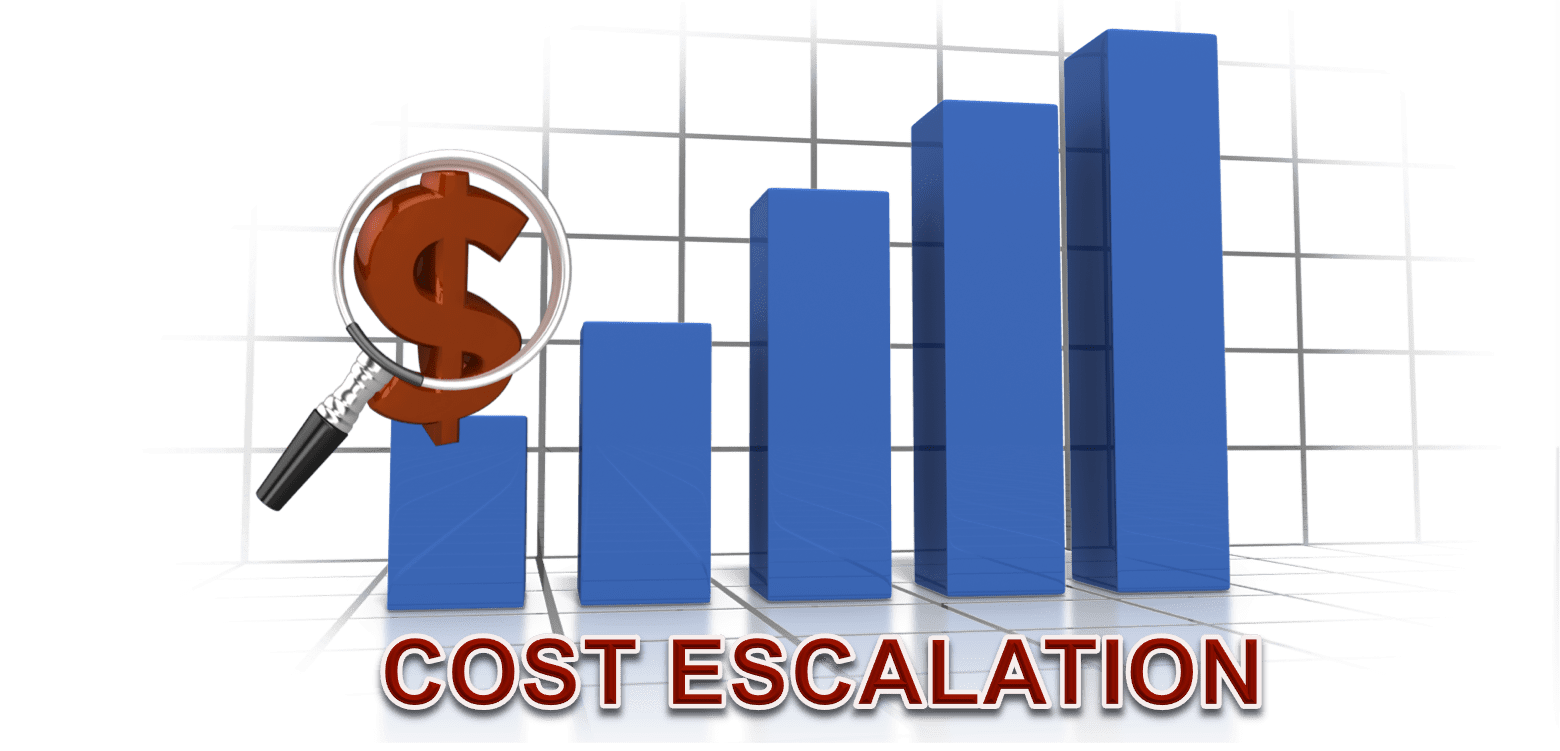According to Wikipedia.org, “Changes in the cost or price of specific goods or services in a given economy over a period of time is defined as “Cost Escalation” [1].
Very often, the common question from an owner to an estimator is “Is your estimate in current dollars or escalated dollars?” Any cost estimate is a projection of cost at a particular point in time. Costs change from one point to another for labor, material, and equipment and by knowing the escalation or anticipated increase, owners may be able to provide for additional funds in their budget.
Escalation is computed as a percentage of the base estimate and shown as a separate line item in budget estimates. Various organizations publish cost index tables, calculated based on periodical price movements, monthly, quarterly and yearly. An estimator may use this historical database to project future cost growth. Sometimes, the price movement could also be downward as it happened during the recessionary period around the year 2009.
Types of Cost Indices
For calculating escalation, the estimator may use an input or output based cost index.
Input based indices are based on the change of the cost of inputs for selected basket of construction labor and materials. The Building Cost Index (BCI) and the Construction Cost Index (CCI) published by Engineering News Record (ENR) are examples of input based indices. RS Means is another publisher of this type of indices.
Output based indices are based on the change of price of the output and not the cost of inputs. In construction, it is the movement in bid prices. These indices are developed taking into account the market conditions, construction business volume, fluctuations in contractor’s margins, etc. [2]. The most commonly referred output index in the industry is the ‘Turner Cost Index (TCI),’ published by Turner Construction Company. Another output index available for use is the ‘Vermeulens Cost Index.’
Which Index to Choose?
The ENR and RS Means input indices are more commonly used in the industry by many owners. Some may prefer to use the output based indices as it is computed combining many factors such as the economy, bidding environment, and market volume. The estimator can also choose any index and make appropriate adjustments based on judgment. Some published economic reports may be referred as a guidance to make the adjustments. One such report published by Gilbane Building company suggests adjustment curves relating ENR Index and contractor margins to calculate margin adjusted costs [2].
Further considerations
Check if owners have any preferences. Some public owners may have their own indices developed in-house based on historical bid information.
Besides cost and time, location is another dimension to escalation. See if the publications provide indices applicable to local cities or states in addition to nationwide numbers. TCI is a nationwide index but ENR and RS Means have city specific indices.
Look into what basket of materials and what labor trades are considered in the development of indices. For example, ENR’s BCI is based on wage rate changes for many different skilled trades whereas the CCI is based on only the common labor wage rate changes. Similarly, ENR’s material group includes only cement. Steel and lumber. If the estimator wants to consider indices that are built-up using a bigger group of construction materials, he or she may look for other relevant publications.
Calculating the Percentage of Escalation
After deciding the type of index that is applicable to the project, the estimator will be able to calculate the percentage change of the index between any two time periods. A sample calculation is shown below taking indices over a period of 3 years.
ENR BCI index [3] for year 2015 = 5564
ENR BCI index [3] for year 2012 = 5210
The percentage change over 3 years = [(5564-5210)/5210] x 100 = 6.8% (or 2.30% per year)
Typically, escalation is calculated applying an annual percentage for the duration from the estimate date to the mid-point of construction and for projects with a duration of two years or more. The practice is to calculate escalation up to the mid-point and not the end of the contract. It is an arbitrary point assuming by then good progress would have occurred and expenses incurred.
The estimator may use his or her discretion in choosing the historical index range over a period of 1, 3, 5 or 10 years and come up with an annual percentage to be applied to the base estimate.
Duration up to the Mid-point is calculated as:
[Duration from Estimate date to start of construction] +[Duration of Construction/2]
Example:
For a project with a duration of 5 years, if construction duration is from Feb 2019 to Feb 2024,
The duration for escalation from Feb 2017 = 2 years + 2.5 years = 4.5 years.
If the above project has a base estimate of $100M, applying an annual percentage (compounded) of 2.3%, for 4.5 years, the escalation amount will be as follows
=100,000,000 x (1.023) ^4.5 – 100,000,000
= $10.77M
It is also important that estimators document the assumptions and calculations along with the type of index used and citations of publications on the Basis of Estimate (BOE).
Escalation Modeling
Some owners prefer to show escalation calculations separately in their budget – One for the period from the estimate date to the start of construction and another for the period from construction start to the mid-point of construction.
If it is a big project, each phase or contract package will have different start points and durations. Instead of applying one single percentage for the entire project, escalation can be calculated individually for separate phases or packages and summed up to get the overall escalation for the project. In this case, it is possible to apply package specific escalation percentages.
One could argue that future trends may not always follow past changes of cost indices. Though it is possible to apply Risk Analysis and develop escalation percentages, it is not common in the industry. Owners think it is still a job of the economists and continue to use published indices.
By familiarizing with the industry publications and Economic reports, understanding the different types of indices, and knowing formulas and calculations, an estimator will be able to measure project escalation and aid owners to provide funds in their budget for the anticipated increases.
References:
2. “Figure 35: Escalation Growth vs Actual Margin Cost 2005-2017”, Construction Economics, Winter 2015-2016, Gilbane building Company
3. Engineering News Record – ENR.com
About the Author: Ramani Sundaram CCP, CEP, MRICS, PMP

He can be reached at [email protected] or his LinkedIn Profile





![[Free 90-min Masterclass] The Ultimate Leadership Recipe for Project Professionals](https://www.projectcontrolacademy.com/wp-content/uploads/2024/08/4-1024x576.jpg)















